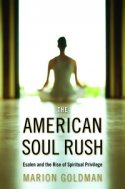EUGENE, Ore. -- (Jan. 10, 2012) -- Fifty years ago the Esalen Institute near Big Sur, Calif., opened its doors to people seeking spiritual growth and personal transformation, attracting psychologists, psychiatrists, social workers, futurists and movie stars. Today, Esalen marches on with workshops, personal retreats and professional massage classes, all designed to help its visitors find restoration and realize their full potential.
 University of Oregon sociologist Marion S. Goldman, also a professor of religious studies, has taken a long look, as an outsider, at Esalen -- its roots and where it may be going -- and presents the institute's impacts on the American consciousness in a deeply researched, just-published book: "The American Soul Rush: Esalen and the Rise of Spiritual Privilege" (New York University Press).
University of Oregon sociologist Marion S. Goldman, also a professor of religious studies, has taken a long look, as an outsider, at Esalen -- its roots and where it may be going -- and presents the institute's impacts on the American consciousness in a deeply researched, just-published book: "The American Soul Rush: Esalen and the Rise of Spiritual Privilege" (New York University Press).
"During its glory days, from the early 1960s until the mid-1970s, famous figures like Timothy Leary and Ken Kesey, the LSD experts, Abraham Maslow, the father of humanistic psychology, and international celebrities like Cary Grant and Jane Fonda flocked to the institute," Goldman said. "Few nationally known figures now gather in Big Sur, but Esalen's influence continues. When Oprah Winfrey and her guests discuss living their best lives, or when Morrie Stein talked about death in 'Tuesdays with Morrie,' they sustain Esalen's mission to deliver ah-ha experiences."
 In her introduction, Goldman -- whose research focuses on new religious movements, including cults, and religious violence -- writes that Esalen has been called "an esoteric think tank, a sacred retreat, a spa, a center for humanistic group psychology, a place for psychedelic trips, a massage school, or an intentional community. The Institute continues to be all of those things and more."
In her introduction, Goldman -- whose research focuses on new religious movements, including cults, and religious violence -- writes that Esalen has been called "an esoteric think tank, a sacred retreat, a spa, a center for humanistic group psychology, a place for psychedelic trips, a massage school, or an intentional community. The Institute continues to be all of those things and more."
Through the rest of the book, Goldman documents how the institute has evolved -- adapting to societal changes and refocusing its approaches -- and how it has left lasting marks throughout American society, including university campuses, churches and synagogues, therapists' offices, health spas and other personal growth centers.
"Although it no longer has a dramatic public presence, the institute continues to be important to the thriving shadow culture where individuals pursue alternative spirituality and emotional fulfillment," Goldman writes.
Esalen's historical significance, Goldman concluded, "rests on the ways that it made the prerogatives of spiritual privilege widely known, meaningful, and accessible throughout the United States. Spiritual privilege is an individual's ability to devote time and resources to select, combine, and revise his or her personal religious beliefs and practices over the course of a lifetime."
The book, in fact, introduces a new theoretical construct: spiritual privilege, which, Goldman said, helps to explain the growth and spread of alternative spirituality in contemporary America.
Esalen transformed spiritual privilege into a human right, she said, building on four attributes: affinities for supernatural meanings, experiences and explanations; religious and cultural knowledge, participation in supportive social networks and economic resources. But, she added: "Its leaders assumed, somewhat erroneously, that almost every American possessed enough of all four elements to select and benefit from the varied practices that emerged in Big Sur."
What's ahead for Esalen? "Some key staff and EMBA [Esalen Massage and Bodywork Association] members have begun to retire and move away or at least cut down their working hours," Goldman writes. "The next decade can usher in Esalen's new beginning or its slow demise depending on whether there is a well-considered plan for succession and internal governance."
It may be time, she added, for Esalen's leadership to revisit the institute's long-running history, much "in the same ways that workshop participants often examine their lives," to find new truths to help reach their constituencies. Esalen also may need to celebrate the elders who have lived and worked there for decades and reach out to younger generations in search of personal transformation.
Readers of the book also will find a bonus. Goldman provides seven different exercises that allow them to experience some of the emotions that make alternative spirituality a rewarding experience.
About the University of Oregon
The University of Oregon is among the 108 institutions chosen from 4,633 U.S. universities for top-tier designation of "Very High Research Activity" in the 2010 Carnegie Classification of Institutions of Higher Education. The UO also is one of two Pacific Northwest members of the Association of American Universities.
Media Contact: Jim Barlow, director of science and research communications, 541-346-3481, jebarlow@uoregon.edu
Source: Marion S. Goldman, professor of sociology and religious studies, 541-346-5167, mgoldman@uoregon.edu
Review Copies: Media wanting a review copy of the book should contact the New York University Press media office.